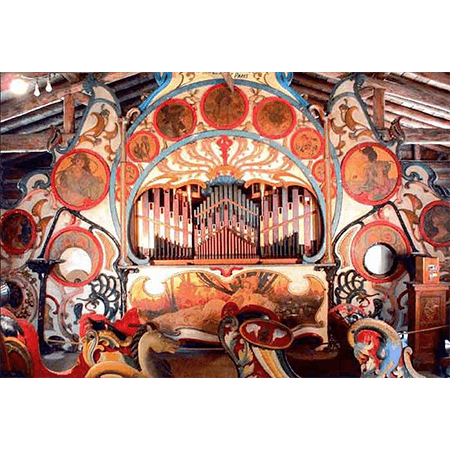
Gavioli 89 Key Band Organ
Manufacture Date:Circa 1900
Song Title: Stars and Stripes Forever
[audio mp3="https://www.virginiacitymusic.xyz/wp-content/uploads/2016/02/stars_and_stripes_forever-1.mp3"][/audio]
The Gavioli 89 Key Band Organ is definitely an instrument that you must see when visiting the Music Hall, actually, it’s an instrument that you can’t miss. Considering the fact that its width takes up the entire back wall of the museum. Only one hundred or so of its size was ever made and only one of the dozen still exist in its unaltered condition worldwide.
The instrument was created by Gavioli et Cie, of Paris, France who was one of the first major builders of fairground organs. He created these instruments as a way to entertain the public primarily while they were on amusement rides, midways, and in skating rings.
The huge organ was originally played by folding cardboard book music and a keyframe with metal “key” levers that read the rectangular holes in the folding cardboard music books. It was later converted to a “keyless” frame in 1959 by Ozzie Wurdeman to play B.A.B. 87 note rolls. This process involved substituting the keyframe with a keyless frame that still exists in the cabinet behind the organ.
It is believed that this item was collected during World War I, it was traded to the USA by the French Government in an attempt to prevent starvation throughout their country. They traded the instrument for a carload (railroad) of flour.
Once the instrument was in the USA it was used in various indoor locations that can be compared to “Coney Island” before it was moved to the shops of the Molinari Organ Works in Brooklyn, NY where it stood entertaining crowns for years.
The Gavioli 89 Key Band Organ was among the many instruments purchased from the B.A.B. Organ Co. and added to Charlie Bovey collection in July 1958. At that time it was the largest and most important organ within the collection. Later, quoted by Art Reblitz, a world-famous automatic musical instrument restoration expert, that this instrument was "One of America's greatest European fairground organs.”
